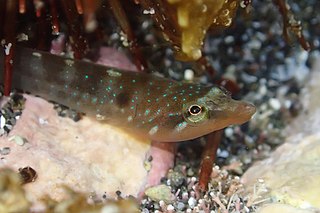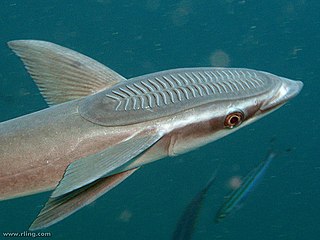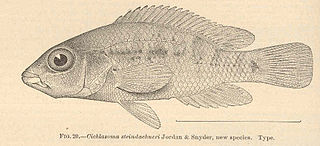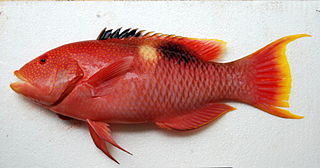Victor Gruschka Springer was an American biologist who was a Senior Scientist emeritus, Division of Fishes at the Smithsonian Institution's National Museum of Natural History in Washington, D.C. He was a specialist in the anatomy, classification, and distribution of fishes, with a special interest in tropical marine shorefishes. He published numerous scientific studies on these subjects; also, a popular book called "Sharks in Question, the Smithsonian Answer Book" 1989.

The New Zealand urchin clingfish is a clingfish. It is found around New Zealand wherever sea urchins are present. Its length is between 2 and 3 cm.

Trichogaster is a genus of gouramis native to South Asia from Pakistan to Myanmar. It is the only genus in the monotypic subfamily Trichogastrinae as set out in the 5th Edition of Fishes of the World, although that book states that there are two genera, the other being Colisa which is treated as a synonym of Trichogaster by Fishbase and the Catalog of Fishes. Fishbase also places the genus in the Luciocephalinae. Species of this genus are very popular in the aquarium trade.
Antipodocottus galatheae, the Galathea sculpin, is a species of marine ray-finned fish belonging to the family Cottidae, the typical sculpins. This species found on the continental shelf around New Zealand. It has also been recorded off Tasmania, New South Wales and Queensland.

Echeneis is a genus of fish in the family Echeneidae, the remoras. The genus is distributed in the Atlantic, Pacific and Indian Oceans.

The scalyhead triplefin is a species of triplefin blenny in the genus Norfolkia. It was described by Allan Riverstone McCulloch and Edgar Ravenswood Waite in 1916. Under the synonym Norfolkia lairdi it was the type species of Fowler's new genus. This species has been recorded from off Queensland, Norfolk Island, Lord Howe Island, New Caledonia and the Loyalty Islands. The adults occur in tidal pools among areas of coral reef.
The Mexican rivulus is a species of killifish from the family Rivulidae which is endemic to Mexico where it is found in the Papaloapan and Coatzacoalcos River basins. This annual killifish grows to a total length of 4 cm (1.6 in). It is the only known species in its genus, but its exact taxonomic position remains uncertain, as it has not been included in any phylogenetic study. This species was described by Robert Rush Miller and Carl Leavitt Hubbs as Rivulus robustus in 1974, it was reclassified in the monotypic genus Millerichthys in 1995, the generic name honouring Robert Rush Miller.

Selar is a genus of ray-finned fishes from the family Carangidae which includes the scads, jacks, pompanos, trevallies and horse mackerels. The generic name, Selar, is the local name for the oxeye scad in Jakarta.
Gerald Robert "Gerry" Allen is an American-born Australian ichthyologist. His career began in 1963, when he spent a semester at the University of Hawaii, where he also received a PhD in marine zoology in 1971. In 1972, Allen wrote his doctoral thesis on the systematics and biology of the anemone fish.

Nosferatu steindachneri, Steindachner's cichlid, is a species of cichlid endemic to Mexico where it is found in the Tamasopo, Gallinas and Ojo Frio Rivers of the Panuco River basin. It reaches a maximum size of 40.0 centimetres (15.7 in) SL. This species can also be found in the aquarium trade. The specific name honours the Austrian ichthyologist Franz Steindachner (1834-1919).
John Ernest "Jack" Randall was an American ichthyologist and a leading authority on coral reef fishes. Randall described over 800 species and authored 11 books and over 900 scientific papers and popular articles. He spent most of his career working in Hawaii. He died in April 2020 at the age of 95.
Helen K. Larson is an ichthyologist who specialises in the fishes of the Indo-Pacific.
Loren Paul Woods (1913–1979) was an American ichthyologist and museum curator at the Field Museum of Natural History In Chicago. He joined the museum's education department as a guide lecturer in 1938. In 1941, he was transferred to the Division of Fishes, from where he retired in 1978. His career was interrupted by a four-year period of duty with the United States Navy during World War II. While he was in the navy, Marion Griswold Grey served as the unpaid curator, becoming an associate at the museum when Woods resumed his post. During his time at the Field Museum, he assembled specimen collections of North American freshwater fish and Atlantic, Indian, and Pacific Ocean marine fish. This material resulted in a major expansion of the museum's fishes holdings, which had previously been a mostly freshwater collection. Woods is best remembered for his publications on damselfish, squirrelfish, and Berycidae.
Nikolai Vasilyevich Parin was a Soviet and Russian ichthyologist, specializing in oceanic pelagic fish. He headed the Laboratory of Oceanic Ichthyofauna at the RAS Institute of Oceanology in Moscow, where he ended his career as a Professor after more than fifty-seven years. In his career, he described more than 150 new taxa of fish and participated in 20 major oceanic expeditions. Thirty-six species of fish are named in his honour.
Eumicrotremus tokranovi is a species of lumpfish native to the Northwest Pacific, and one of two species some authorities place in the genus Microancathus. It is known from the Kuril Islands. It is distinguished from the closely related E. fedorovi by a taller body and flatter and less developed bone plaques. FishBase does not recognize the genus Microancathus,. This species was described by the Russian ichthyologist Olga Stepanovna Voskoboinikova in 2015 in the proposed new genus, Microancathus and the reclassification of M. fedorovi in that genus. Catalog of Fishes does not recognize the new genus and classifies this species in Eumicrotremus. The specific name honors the ichthyologist Alexei Mikhailovich Tokranovof the Kamchatka Branch of the Pacific Institute of Geography and the Far East Branch of the Russian Academy of Sciences.

Bodianus perditio, the golden-spot hogfish, is a species of wrasse. It is found in the Pacific Ocean.
Dolichopteryx andriashevi is a species of fish endemic to in the Philippine Sea.
Dolichopteryx trunovi, the tailspot barracudina, is a species of fish found in the oceans of the Southern hemisphere.
Dolichopteryx parini, the winged spookfish, is a species of fish found in the Pacific Ocean.
Psednos barnardi, the blackchin dwarf snailfish, is a species of snailfish found in the north-western Atlantic Ocean.






